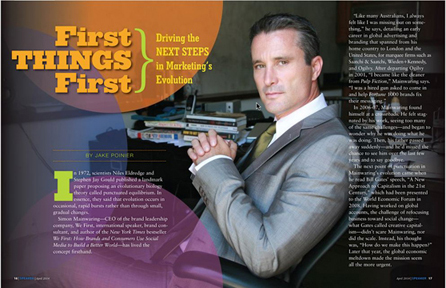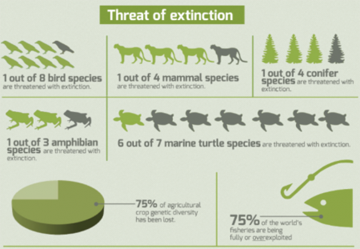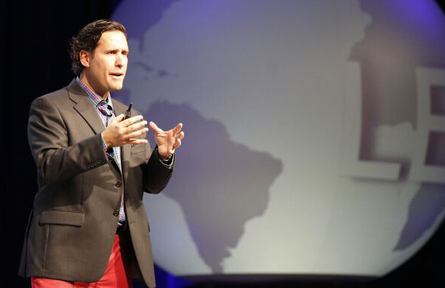
Purposeful Branding, with Simon Mainwaring
| Many brands will fall by the wayside because they are either promoting advertising that no one wants in their life or talking about their purpose in a self-directed way that falls on deaf ears. | |
| |
 | In today's competitive social media environment, what can brands do to stand out from the crowd? |
 | Brands need to clearly define their purpose and the impact they want to have on the world so they can lead a meaningful and relevant conversation with their stakeholders that transcends their products services or category. Without this, many brands will fall by the wayside because they are either promoting advertising that no one wants in their life or talking about their purpose in a self-directed way that falls on deaf ears.
Instead a brand must be a chief celebrant of its customer community rather than its celebrity, and demonstrate its commitment to improving the lives of its stakeholders so that they in turn will talk about the brand and build its business. This is how brands leverage the dialogue that now takes place between companies and their customers to their advantage to carve out a competitive leadership position |
 | What are brand's three fatal mistakes they make when trying to engage with customers on social media? |
 | It’s hard to choose but here are three mistakes that undermine all of the good work that marketers are doing from a social impact POV.
(1) They talk about their purpose in a self-directed way that comes off at self-interested despite the positive impact they are having. For example, they talk about the donations they have received or the hours that their employees have volunteered, rather than celebrating the impact on the lives of those they care about. (2) Anxious to get a return on investments for their purposeful initiatives, brands rush straight past their brand story to the telling and fail to clearly define what difference they want to make in the world in a way that is proprietary and carves out a competitive advantage. In doing so, they go straight to marketing rather than defining, framing and sharing their brand story with employees who could become the most powerful advocates for the brand. (3) Brands mistake their category for their purpose. For instance, they want to be more sustainable or support a cause like breast cancer research and fail to define a unique point of view within that broader category. As a result, their messaging and effort is lost in the noise of “me too” brands that have similar goals rather than carving out a unique point of view that cuts through the clutter. |
| A brand must lead with its legacy rather than simply focus on the company, its products and social impact – in that order. | |
| |
 | How can brands better express their sustainable branding message to their customers? |
 | The fundamental shift that must take place in the mindset of a brand is that marketing is no longer about the company itself, but rather how the company can mobilize its internal and external stakeholders to realize its impact goals on the basis of shared values and purpose.
To achieve this, a brand must clearly articulate what difference it will make in the world and how employees, customers and consumers lives will be richer for their participation in the movement. In doing so, a brand won’t just create marketing around it’s sustainability efforts, but rather will lead a conversation with shapes culture and our future. In short, a brand must lead with its legacy rather than simply focus on the company, its products and social impact – in that order. |
 | Is sustainable branding a 'fad' or is it here to stay? |
 | Sustainability branding is a mainstay of marketing moving forward because the web has made customers, consumers and society intimately aware of the compounding crisis we face, from climate change to ocean acidification and beyond. At the same time, social media has connected consumers in a way that was never possible before allowing them to rally around the causes and brands they care about. Finally, younger demographics that include millennials and gen Z have driven a powerful shift in the marketplace that can be described as a shift from a value to a values proposition. So sustainability branding is no more a fad than we can turn back the internet, social media or mobile phones, or the compounding social crisis’s that are now increasingly defining our experience of life. |
| Brands such as Unilever, Patagonia and Telsa are doing it right because they are operating as a mission with a company, rather than a company with a mission. | |
| |
 | Which brands do you think are getting it right? |
 | Brands such as Unilever, Patagonia and Telsa are doing it right because they are operating as a mission with a company, rather than a company with a mission. In doing so, they create marketing that is a function of their core mission rather than as an extension of their brand or products. This results in a powerful demonstration of values that resonates with consumers in a way that inspires them to be champions for the brand whether that takes the form of a marketing campaign or a social impact initiative.
As such, these brands operate as community architects that enlist their stakeholders and change agents in service of a vision of the future that is both aspirational and unique to the brand. It is these brands that are defining the future by creating it and that are mobilizing movements for change that are building their business. ========================================================= |


















